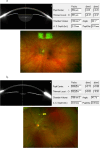Predictive factors at initial visit for sunset glow fundus in Vogt-Koyanagi-Harada disease
- PMID: 40624077
- PMCID: PMC12234651
- DOI: 10.1038/s41598-025-08252-3
Predictive factors at initial visit for sunset glow fundus in Vogt-Koyanagi-Harada disease
Abstract
This study aimed to identify factors present at the initial visit for the development of sunset glow fundus (SGF) in Vogt-Koyanagi-Harada (VKH) disease. A total of 139 eyes from 70 naïve patients with acute VKH disease who underwent pulse steroid therapy were categorized into "SGF" and "non-SGF" groups based on fundus appearance at 12 months post-therapy. Multivariable analysis revealed that patients with meningismus (p = 0.004), incomplete type (p = 0.035), and probable type (p = 0.002) in older revised diagnostic criteria; ex-smoker (p = 0.016), and smoker (p = 0.010) status; high logarithmic best-corrected visual acuity (BCVA) (p < 0.001); high spherical equivalent (SE) (p = 0.005); shallow peripheral anterior chamber depth (ACD) (p < 0.001); narrow anterior chamber angle (ACA) (p = 0.015); increased pupil diameter (p < 0.001); and thicker cornea (p = 0.019) were associated with SGF. The optimal cut-off values for predicting SGF were identified as follows: logarithmic BCVA greater than 0.261, SE exceeding - 2.813 D, peripheral ACD less than 2.138 mm, ACA less than 40.55 °, pupil diameter exceeding 3.040 mm, and corneal thickness exceeding 579.500 μm. Patients with VKH disease who exhibit above risk factors require early and careful management.
Keywords: Corneal thickness; Pupil diameter; Sunset glow fundus; Visual acuity; Vogt–Koyanagi–Harada disease.
© 2025. The Author(s).
Conflict of interest statement
Declarations. Competing interests: The authors declare no competing interests.
Figures



Similar articles
-
Early Changes in Ocular Biomarkers in Patients with Vogt-Koyanagi-Harada Disease after Pulse Steroid Therapy.Ophthalmologica. 2025;248(1):40-53. doi: 10.1159/000542724. Epub 2024 Nov 21. Ophthalmologica. 2025. PMID: 39571547 Free PMC article.
-
Optical Coherence Tomography Biomarkers in Acute Vogt-Koyanagi-Harada Disease: Clinical Significance of Hyperreflective Outer Nuclear Layer and Bacillary Layer Detachment.Ocul Immunol Inflamm. 2025 Aug;33(6):986-993. doi: 10.1080/09273948.2025.2504583. Epub 2025 May 15. Ocul Immunol Inflamm. 2025. PMID: 40372790
-
Predictive factors and adalimumab efficacy in managing chronic recurrence Vogt-Koyanagi-Harada disease.BMC Ophthalmol. 2024 Jun 7;24(1):238. doi: 10.1186/s12886-024-03511-9. BMC Ophthalmol. 2024. PMID: 38849758 Free PMC article.
-
Non-biologic, steroid-sparing therapies for non-infectious intermediate, posterior, and panuveitis in adults.Cochrane Database Syst Rev. 2022 Oct 31;10(10):CD014831. doi: 10.1002/14651858.CD014831.pub2. Cochrane Database Syst Rev. 2022. PMID: 36315029 Free PMC article.
-
Vogt-Koyanagi-Harada disease: recurrence rates after initial-onset disease differ according to treatment modality and geographic area.Int Ophthalmol. 2020 Sep;40(9):2423-2433. doi: 10.1007/s10792-020-01417-1. Epub 2020 May 16. Int Ophthalmol. 2020. PMID: 32418076 Review.
References
-
- Nakayama, M., Keino, H., Watanabe, T. & Okada, A. A. Clinical features and visual outcomes of 111 patients with new-onset acute Vogt–Koyanagi–Harada disease treated with pulse intravenous corticosteroids. Br. J. Ophthalmol.103, 274–278 (2019). - PubMed
-
- Abu El-Asrar, A. M. et al. Chronic recurrent Vogt–Koyanagi–Harada disease and development of ‘sunset glow fundus’ predict worse retinal sensitivity. Ocul Immunol. Inflamm.25, 475–485 (2017). - PubMed
MeSH terms
LinkOut - more resources
Full Text Sources

